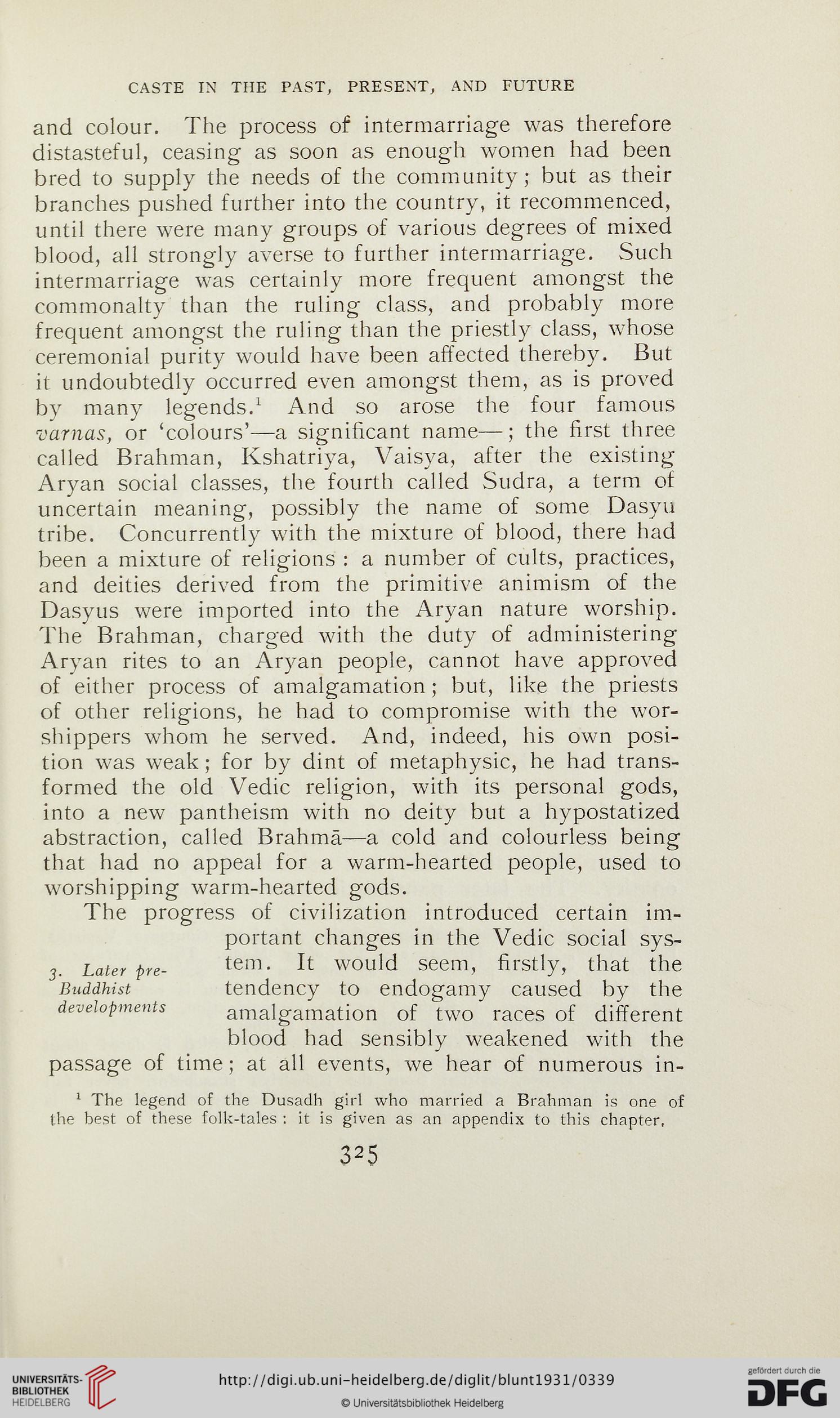CASTE IN THE PAST, PRESENT, AND FUTURE
and colour. The process of intermarriage was therefore
distasteful, ceasing as soon as enough women had been
bred to supply the needs of the community; but as their
branches pushed further into the country, it recommenced,
until there were many groups of various degrees of mixed
blood, all strongly averse to further intermarriage. Such
intermarriage was certainly more frequent amongst the
commonalty than the ruling class, and probably more
frequent amongst the ruling than the priestly class, whose
ceremonial purity would have been affected thereby. But
it undoubtedly occurred even amongst them, as is proved
by many legends.1 And so arose the four famous
varnas, or ‘colours’—a significant name—; the first three
called Brahman, Kshatriya, Vaisya, after the existing
Aryan social classes, the fourth called Sudra, a term of
uncertain meaning, possibly the name of some Dasyu
tribe. Concurrently with the mixture of blood, there had
been a mixture of religions : a number of cults, practices,
and deities derived from the primitive animism of the
Dasyus were imported into the Aryan nature worship.
The Brahman, charged with the duty of administering
Aryan rites to an Aryan people, cannot have approved
of either process of amalgamation ; but, like the priests
of other religions, he had to compromise with the wor-
shippers whom he served. And, indeed, his own posi-
tion was weak; for by dint of metaphysic, he had trans-
formed the old Vedic religion, with its personal gods,
into a new pantheism with no deity but a hypostatized
abstraction, called Brahma—a cold and colourless being
that had no appeal for a warm-hearted people, used to
worshipping warm-hearted gods.
The progress of civilization introduced certain im-
portant changes in the Vedic social sys-
3. Later pre- tem- It would seem, firstly, that the
Buddhist tendency to endogamy caused by the
developments amalgamation of two races of different
blood had sensibly weakened with the
passage of time; at all events, we hear of numerous in-
1 The legend of the Dusadh girl who married a Brahman is one of
the best of these folk-tales : it is given as an appendix to this chapter,
325
and colour. The process of intermarriage was therefore
distasteful, ceasing as soon as enough women had been
bred to supply the needs of the community; but as their
branches pushed further into the country, it recommenced,
until there were many groups of various degrees of mixed
blood, all strongly averse to further intermarriage. Such
intermarriage was certainly more frequent amongst the
commonalty than the ruling class, and probably more
frequent amongst the ruling than the priestly class, whose
ceremonial purity would have been affected thereby. But
it undoubtedly occurred even amongst them, as is proved
by many legends.1 And so arose the four famous
varnas, or ‘colours’—a significant name—; the first three
called Brahman, Kshatriya, Vaisya, after the existing
Aryan social classes, the fourth called Sudra, a term of
uncertain meaning, possibly the name of some Dasyu
tribe. Concurrently with the mixture of blood, there had
been a mixture of religions : a number of cults, practices,
and deities derived from the primitive animism of the
Dasyus were imported into the Aryan nature worship.
The Brahman, charged with the duty of administering
Aryan rites to an Aryan people, cannot have approved
of either process of amalgamation ; but, like the priests
of other religions, he had to compromise with the wor-
shippers whom he served. And, indeed, his own posi-
tion was weak; for by dint of metaphysic, he had trans-
formed the old Vedic religion, with its personal gods,
into a new pantheism with no deity but a hypostatized
abstraction, called Brahma—a cold and colourless being
that had no appeal for a warm-hearted people, used to
worshipping warm-hearted gods.
The progress of civilization introduced certain im-
portant changes in the Vedic social sys-
3. Later pre- tem- It would seem, firstly, that the
Buddhist tendency to endogamy caused by the
developments amalgamation of two races of different
blood had sensibly weakened with the
passage of time; at all events, we hear of numerous in-
1 The legend of the Dusadh girl who married a Brahman is one of
the best of these folk-tales : it is given as an appendix to this chapter,
325




